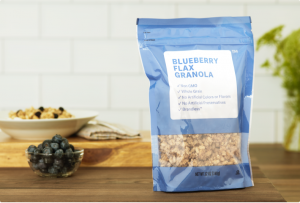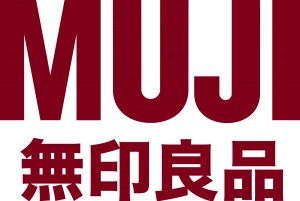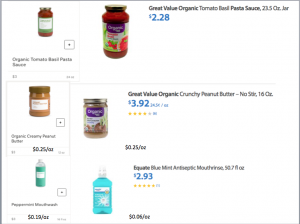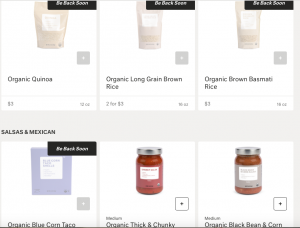Is the future of shopping Brandless?
Brandless is an interesting new online business which launched in the US this week, backed by $50million in venture capital funding. The site offers what the company describes as “A thoughtful, irresistible selection of the food and household products you reach for every day.” The key feature is, as the name suggests, that there are …. no brands. The founders claim to offer top quality basic items for 40% less than national brands by cutting out what they call ‘brand tax’: the costs of distributing, promoting and advertising famous brands. Your BrandTax™ savings will be calculated quarterly and reflected on your account page, according to the website.
Below we look at some of the learnings from this new launch.
1. Simplifies life
Without having the data to back it up, I’d bet that the bulk of online supermarket shopping consists of essentials that require weekly, monthly re-shopping, all done using ‘system 1’ autopilot thinking. Having no brand or sub-brands to choose from is one way to make that job even easier. And to make even easier, all products retail at the same price: 3 Dollars. No time wasted on comparing prices.

2. Borrowing with pride
 The Brandless founders have borrowed with pride, which is a great source of inspiration for new products and services. First, the Japanese retailer Muji has been selling stationary, homeware and clothing with exactly the same concept for decades. In the Japanese label for Muji (無印良品) the first character, 無 (mu), means “without.” The second character, 印 (jirushi), means “brand.” “Muji” is simply short for “Mujirushi Ryōhin” or “brandless quality goods,” according to this source.
The Brandless founders have borrowed with pride, which is a great source of inspiration for new products and services. First, the Japanese retailer Muji has been selling stationary, homeware and clothing with exactly the same concept for decades. In the Japanese label for Muji (無印良品) the first character, 無 (mu), means “without.” The second character, 印 (jirushi), means “brand.” “Muji” is simply short for “Mujirushi Ryōhin” or “brandless quality goods,” according to this source.
But what about that cool feature of offering everything at $3? That’s new right? Not really. Walk down a UK high street and you will find several ‘pound stores’, such as Poundland, where everything is sold for £1. In the US, Dollar Store and Dollar Fanastic are based on a similar idea.
 3. Value innovation
3. Value innovation
Brandless is a good example of ‘value innovation’: more of what you want, less of what you don’t want: All products are clearly steered towards consumers who care about product ethics and ingredients. “We rigorously vet, taste, try, and sometimes create hundreds of formulations for deliciousness, safety, quality, and pure goodness. From there, we partner with our suppliers to create packaging that makes sense and limits waste,” states the website. The simple, uncluttered packs amplify this, with clear front-of-pack list of ingredients, and a ‘Brand Tax Free’ mention. And all this for what the founders claim is 40% less than a national brand.
4. Direct route to consumer
Brandless is another example of a brand creating their own retail presence, a powerful distribution strategy we’ve posted on before using the examples of Nespresso, Hotel Chocolat and Dollar Shave Club. “Most CPG companies don’t have any relationship with consumers,” rightly point out co-founder Tina Sharkey. “Their customers are the stores, not the end consumer.” With the retailer pressure and its impact on not only margins, but also product range, and pricing/promotion strategy, there are some big advantages for brands who from the start own the ‘route to consumer’.
5. Brandless is in a brand battle
Brandless™? Bloody hilarious. Full marks to founder Tina Sharkey for keeping a straight face when presenting Brandless™ as being a company removing the Brand Tax™ and offering Just What Matters™. Clearly she is a big believer in brands, as shown by the liberal use of ™ trademarks. In reality, Brandless is in a brand battle of its own against retailer own brands, who have for years being offering good quality alternatives to national brands at a discount. A quick look at Wal Mart’s website shows that you can buy organic pasta sauce, organic peanut butter and mouthwash for the same or less that on the Brandless website. The Walmart slogan, ‘Save Money. Live Better’, wouldn’t be out of place on Brandless.

6. Need to get the basics right
The success of Brandless will depend on becoming the preferred online grocery retailer for millions of Americans. And earning this trust means getting the basics right, time after time. And it is here where Brandless need to fix some teething troubles fast. A quick browse on the site showed that a number of items are already out of stock (see below), which is a bit concerning given the limited range of products on sale. Keep getting this wrong and interested trialists are unlikely to become repeat shoppers.

In conclusion, Brandless is an intriguing new launch. Their challenge is to build a proposition that is distinctive enough versus national brands and especially retail own label to create a sustainable business. Is what they are offering different enough from known and trusted retailers like Wal Mart and also Amazon to justify people changing their shopping habits, given that the prices are the same or more expensive that own label equivalents? Time will tell.


